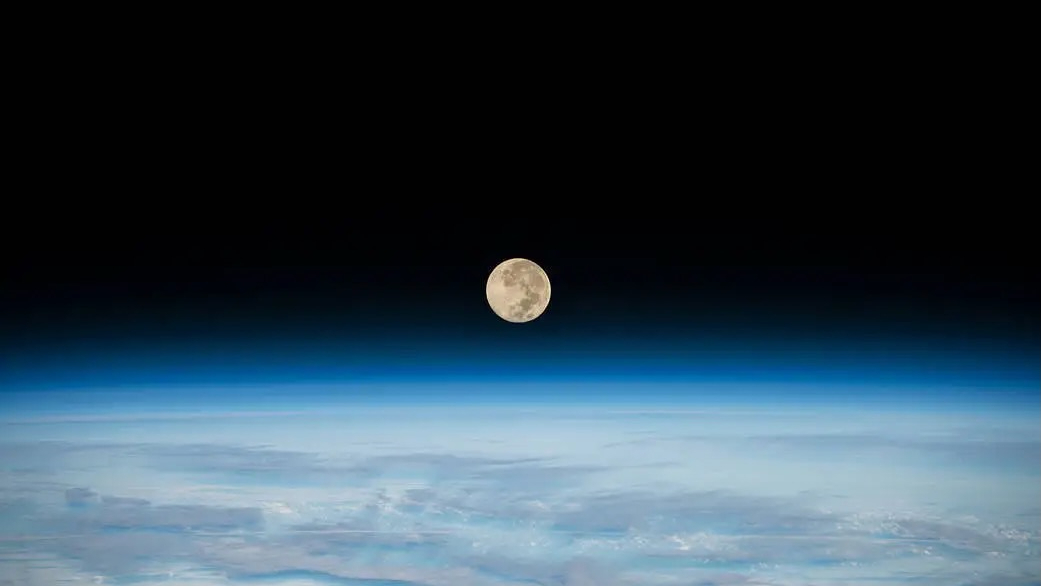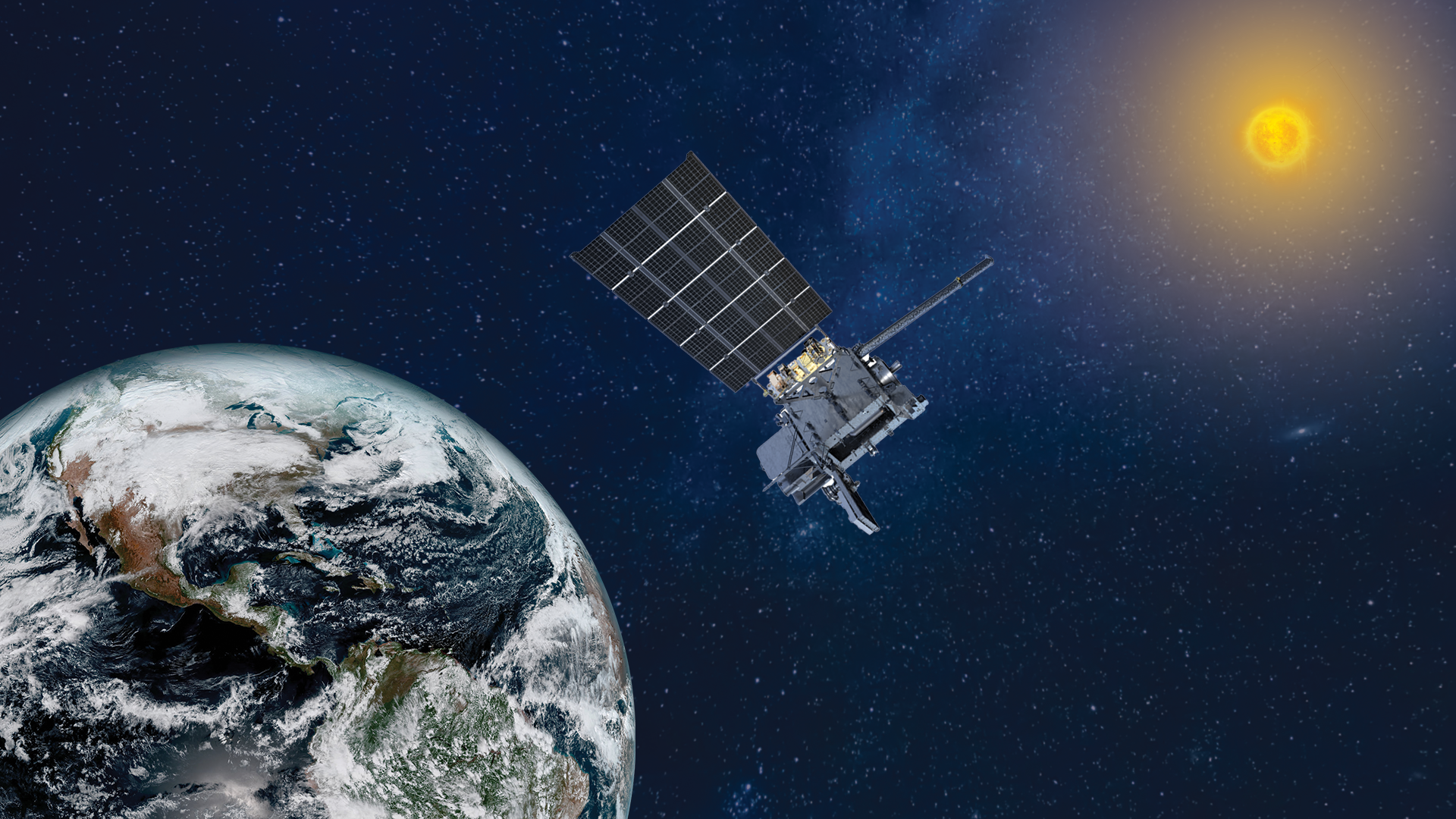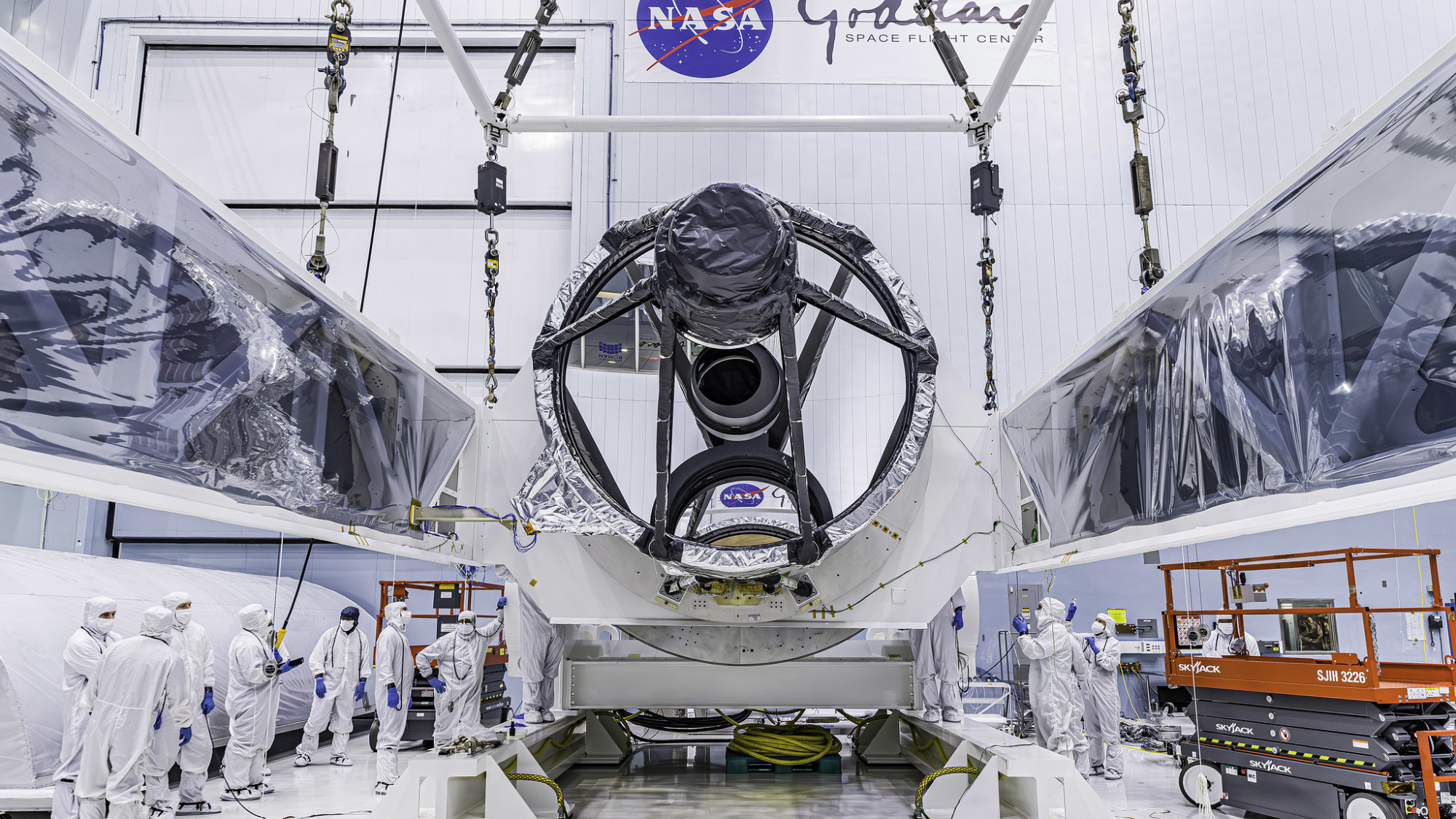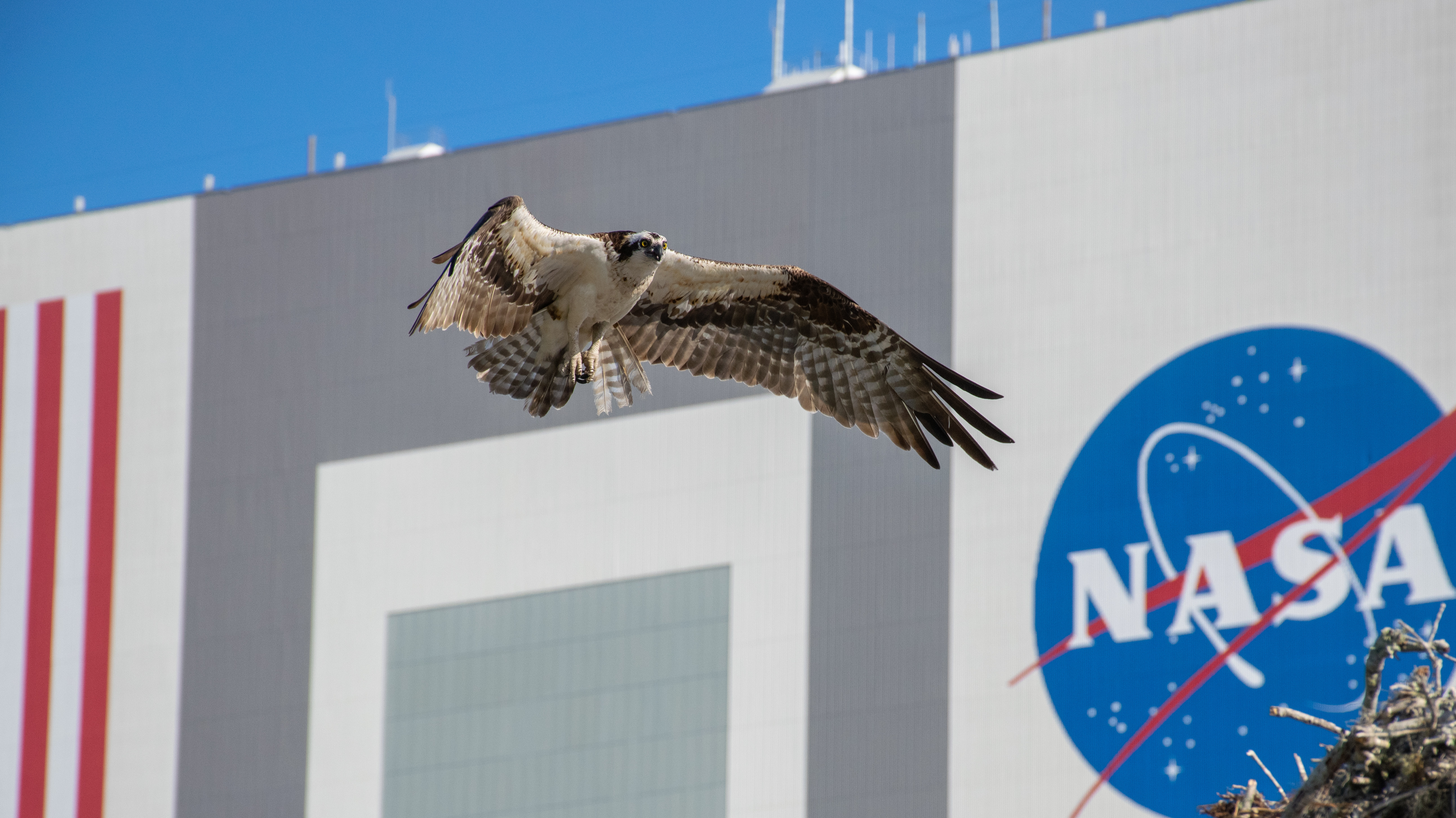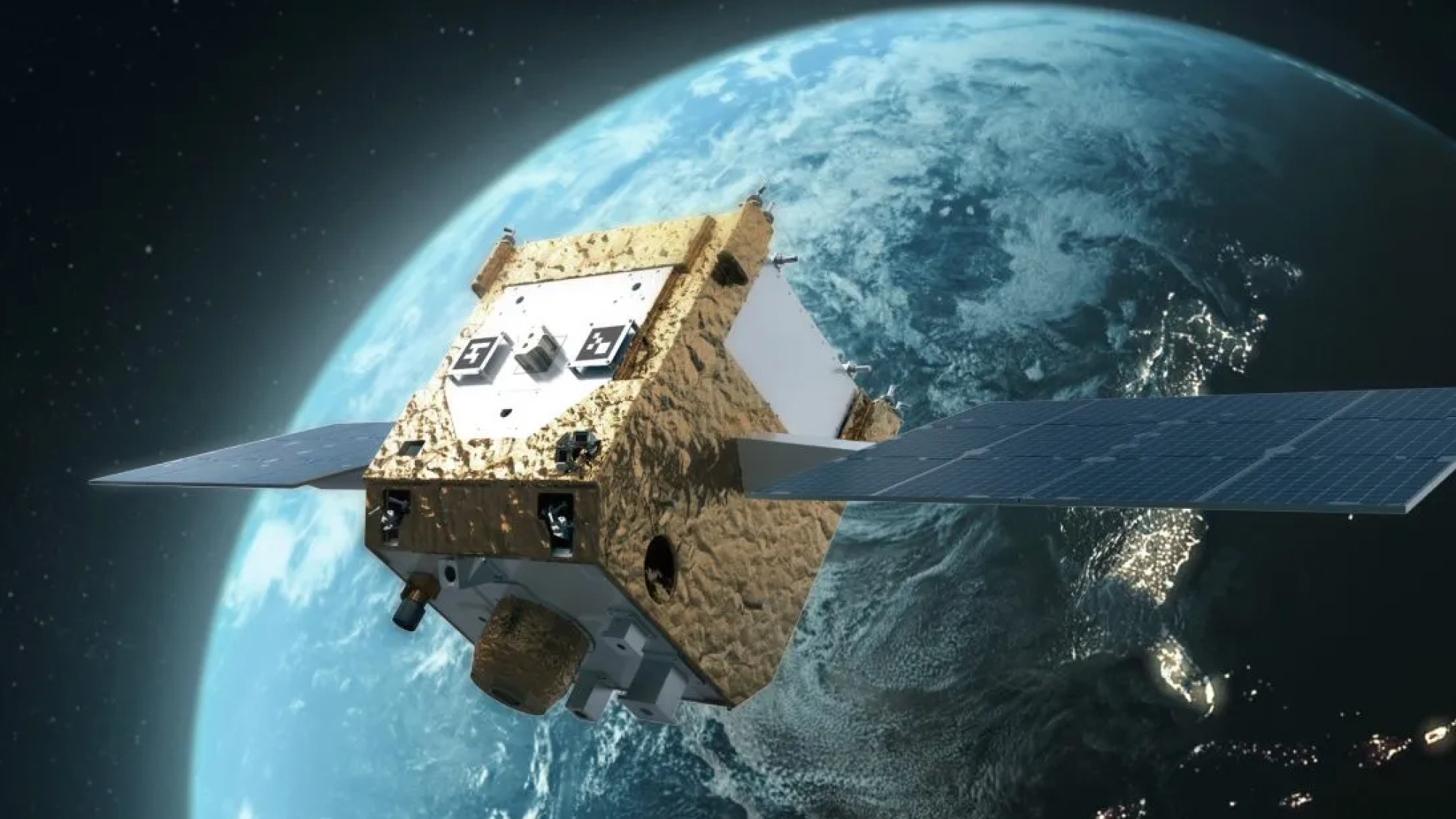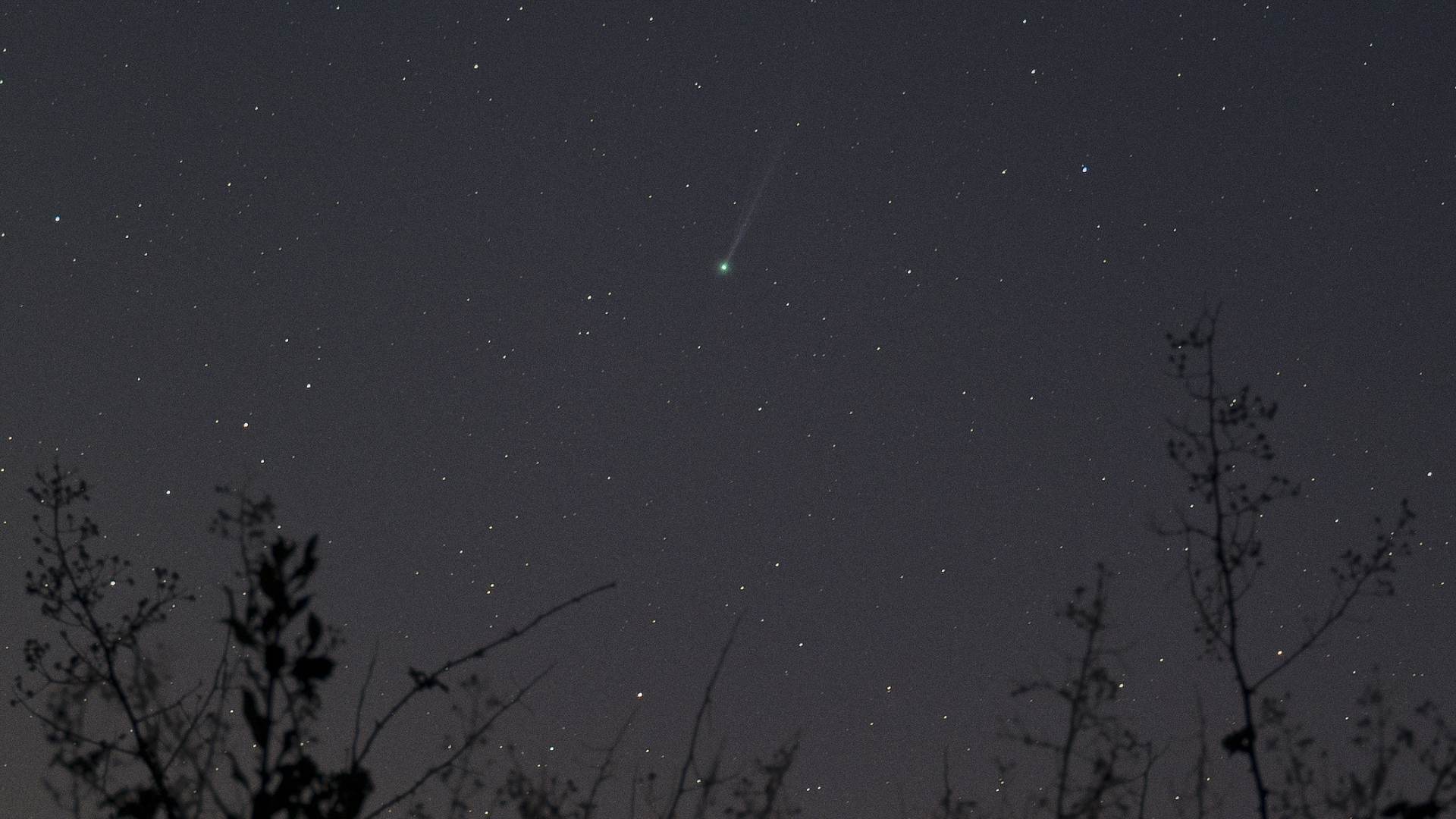
Skywatchers throughout the Northern Hemisphere are enjoying views of the newly discovered Comet SWAN.
This latest cosmic interloper was first sighted on March 29 by Vladimir Bezugly of Dnipro, Ukraine, who found an apparent moving object (a promising candidate for a possible comet) in daily images obtained from March 22 to March 28 with the Solar Wind Anisotropies (SWAN) camera on the Solar and Heliospheric Observer (SOHO), a spacecraft run jointly by the European Space Agency and NASA.
Confirming Bezugly's discovery, also on March 29, Michael Mattiazzo of Swan Hill in Australia reported "a pretty obvious comet" near the edge of the SWAN frames. On April 1, an announcement of the new comet was posted on the internet discussion group comets-ml, eventually leading to lots of confirming observations after a great deal of effort of searching the area given by the approximate SWAN positions. Since then, nearly 300 observations of the comet have been made, including the discovery of images that were taken of it going as far back as last September.
These observations have allowed for reliable orbital computations, which show that the comet will arrive at perihelion — its closest approach to the sun — on May 1, when it will be just 31 million miles (49.9 million kilometers) away.
That's closer than Mercury, the innermost planet to the sun. On the same day, the comet will also be at perigee — its closest point to Earth — at 89.5 million miles (144.0 million km) away. As a consequence, the best opportunity for sighting this new object is in the coming weeks.
Related: New comet SWAN 25F is turning heads — and telescopes — toward the morning sky
Attaching a name has changed
Once upon a time, the art of finding a comet lay solely with assiduous skywatchers, who would spend countless hours scanning the skies in hopes of making a discovery they could call their own; their name would be attached to the comet.
Get the Space.com Newsletter
Breaking space news, the latest updates on rocket launches, skywatching events and more!
Nowadays, however, thanks to robotic cameras and orbiting satellites, which usually catch incoming comets long before they are visible to human eyes, the meticulous art of comet hunting is practiced by very few individuals. Our new comet has been officially catalogued as C/2025 F2 (SWAN), after the orbiting camera that first sighted it.
It's a gas!
Comets come in two varieties: gas and dust. The comets that are rich in dust tend to put on the best shows visually, mainly because dust is an excellent reflector of sunlight; they appear white or yellowish in color.
In addition, the associated dust tails appear broad and quite bright and have a tendency to appear curved, since the dust particles that are ejected from the comet's nucleus usually lag somewhat behind the comet's head. These are the comets that dazzle us the most and make headlines in the news media. Many of the so-called "Great Comets" of the past, such as Hale-Bopp, West and Halley are dusty comets.
Gas comets, on the other hand, shine more by fluorescence; their gases are excited by their reaction to the ultraviolet radiation emitted by the sun. Such comets appear to glow with a bluish or greenish hue. If bluish, then the gas being emitted is composed chiefly of ionized carbon monoxide (CO+), which glows blue when it absorbs sunlight and then re-emits it at a specific wavelength.
If the color is greenish, then the comet is emitting diatomic carbon (C2) gas, which glows characteristically green when excited by the sun's ultraviolet light. While such colors show up well in photographs, the human eye usually has trouble seeing them. Gas comets tend to appear as fuzzy or diffuse blobs of light in binoculars and telescopes. Their tails (sometimes called ion tails) are generally long, straight, faint and narrow. Overall, the combination of a large head and narrow tail give gaseous comets the appearance of an apple on a stick.
Recent photographs of C/2025 F2 (SWAN) reveal a distinctly green or blue-green color, indicating that it's a comet that consists primarily of gas. That indicates that views of it, either with the naked eye or with binoculars and small telescopes, will likely reveal it as a diffuse or fuzzy ball of light accompanied by a faint, straight and narrow tail.
Related: Comets: Everything you need to know about the 'dirty snowballs' of space
When and where to look
For the next couple of weeks, any views of C/2025 F2 (SWAN) will be confined to the morning hours prior to sunrise. From now through April 25, those hoping to get a glimpse of this comet will need to find a location with a clear and unobstructed view of the northeast horizon.
Start watching no later than 70 minutes before sunrise — the start of nautical twilight, which is when the disk of the sun is positioned 12 degrees below the horizon. (Your clenched fist held at arm's length measures approximately 10 degrees in width.) Although the eastern sky will already have begun to brighten, the sky will still be dark enough to discern many of the brighter stars and constellations.
The comet will appear to shift its position against the background stars, and during this two-week time frame it will appear to track from the upper left corner of the famous Great Square of Pegasus through the stars of Andromeda and down to near the base of the small constellation of Triangulum, the Triangle.
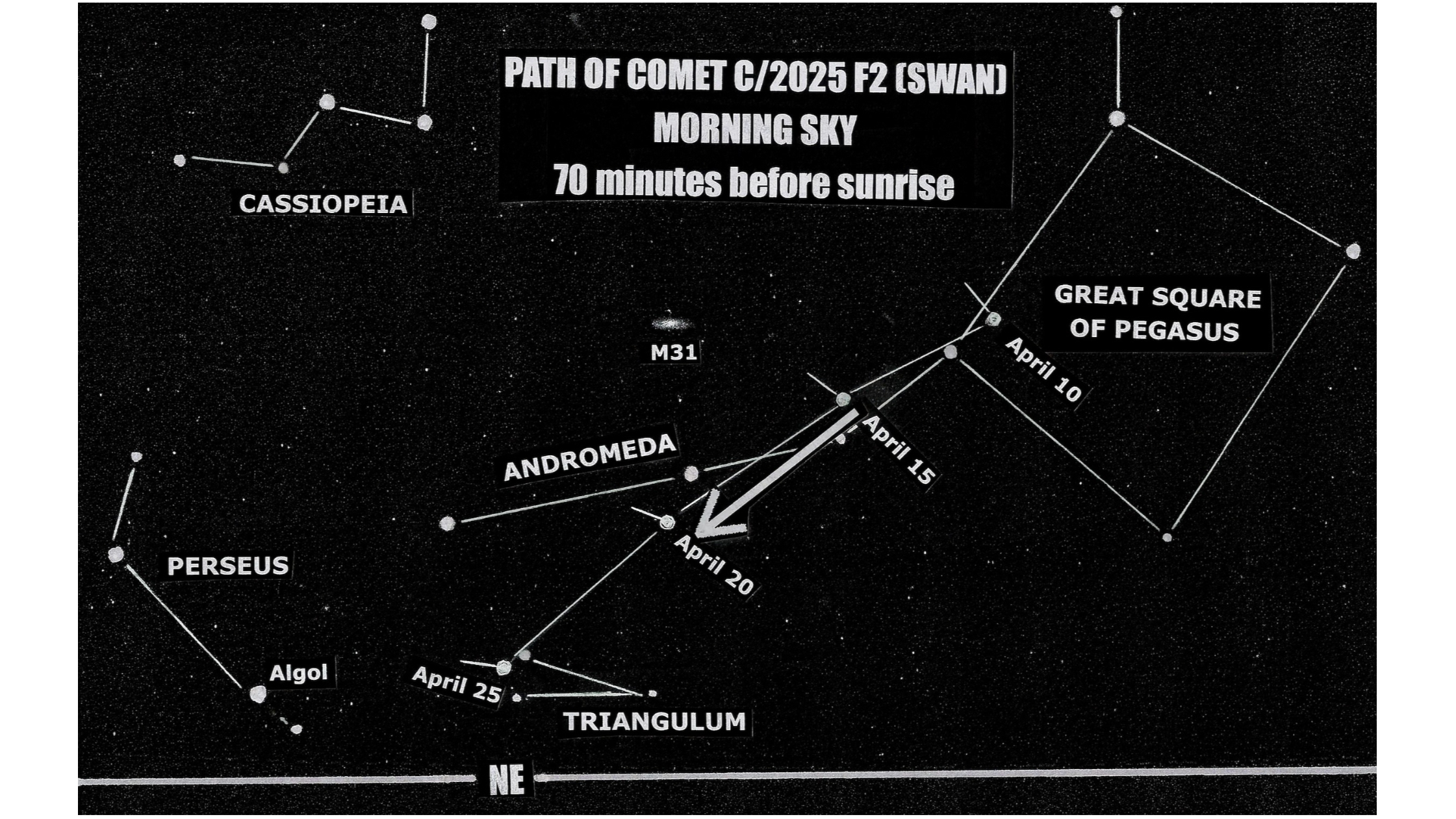
April 24 is "transition day" for C/2025 F2 (SWAN), as it moves from morning to evening sky visibility. To see the comet during the more convenient evening hours, you'll need a clear and unobstructed view of the west-northwest horizon and must wait until the sky has gotten sufficiently dark, beginning no earlier than 70 minutes after local sunset.
During the final week of April, the comet will move from near Triangulum to just above and to the right of the famous Pleiades star cluster by May 1. If you have binoculars and can locate the Pleiades in the late twilight sky low in the west-northwest on that night, then the comet should be evident as a circular glow to the upper right of the cluster.
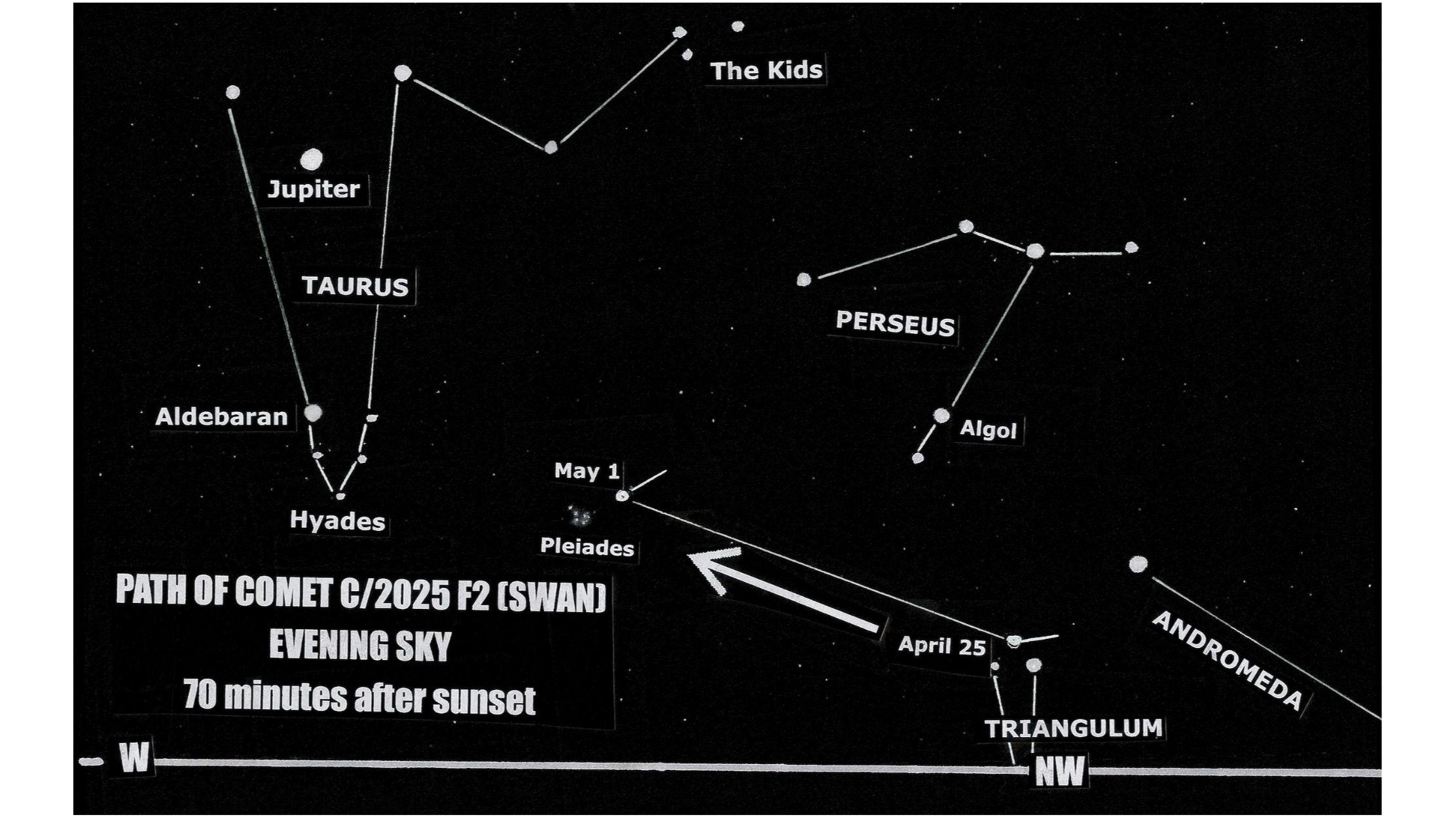
In the nights that follow, the comet will rapidly drop lower in the sky and deeper into the evening twilight glow. It will likely be out of reach for viewing after May 5.
In the two tables below, we provide the morning and evening positions of C/2025 F2 (SWAN) based on its azimuth — its distance in angular degrees from the east or west point of the horizon and its altitude in angular degrees at that point above the horizon. The morning positions coincide with the start of nautical twilight (70 minutes before sunrise), and the evening positions coincide with the end of nautical twilight (70 minutes after sunset). Used in conjunction with our sky maps, these tables should give you a good idea as to where to look to find the comet.
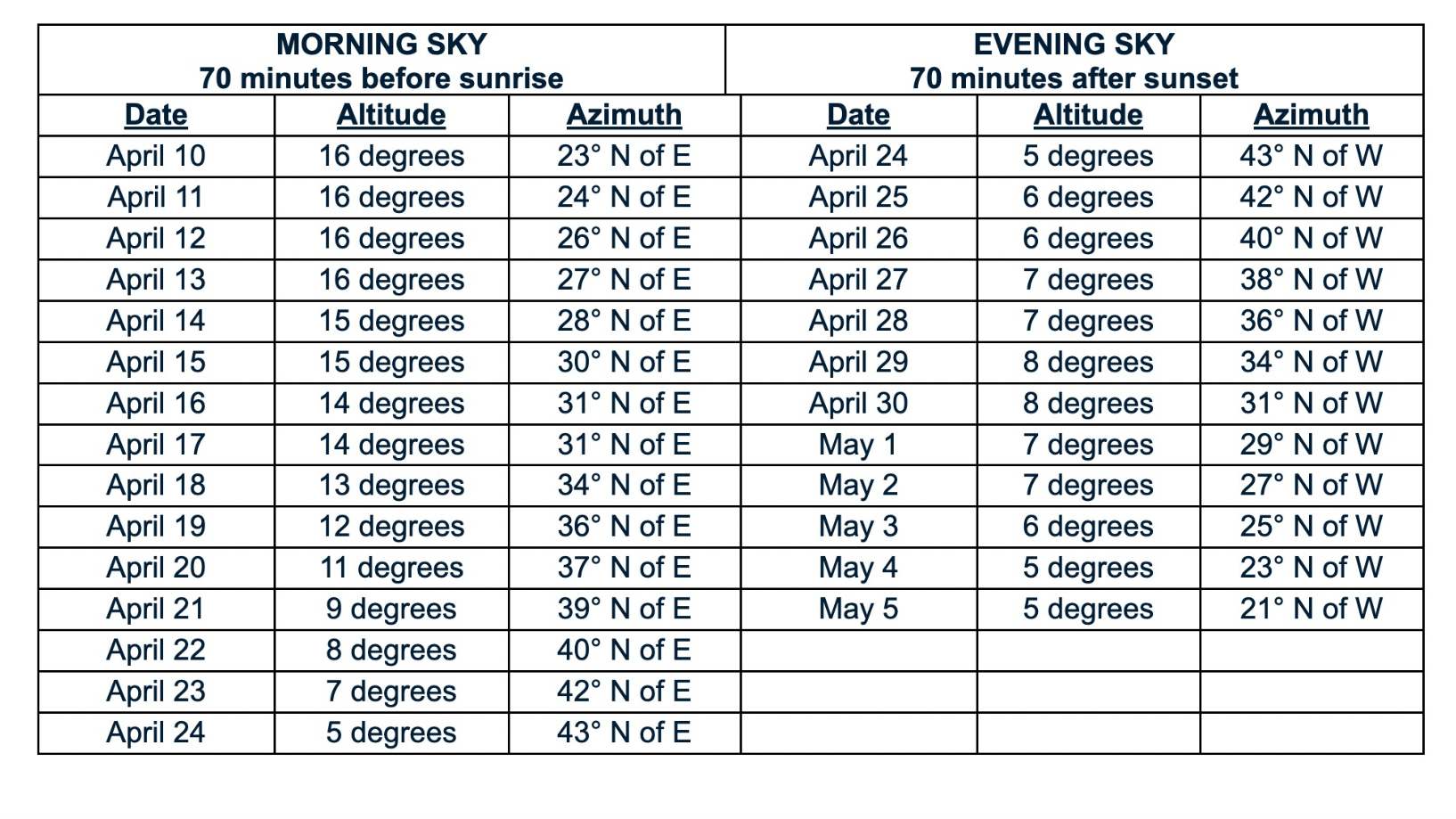
How bright will it get?
Forecasting how bright a comet will get is always a tricky proposition, made all the trickier when the comet is a newly discovered one with no record of any previous apparitions to fall back on. Circular #5538 from the Central Bureau for Astronomical Telegrams goes into a technical discussion describing the history of C/2025 F2 (SWAN) and finishes with an ephemeris — a table or data file giving the calculated positions of a celestial object at regular intervals throughout a period, from which one can plot an accurate finder chart.
So, how bright the comet will get? In Circular #5538, astronomer Daniel Green notes:
"Observers have commented on a clear outburst in brightness having occurred around April 5. Predicting the comet's brightness as it approaches perihelion is necessarily highly uncertain."
The best forecasts seem to suggest that the comet will brighten from around 7th magnitude on April 10 to 5th magnitude by April 21 to possibly 4th magnitude by April 27. So, during the final week of April, the comet might be dimly visible with the unaided eye from a dark, non-light-polluted location. Certainly, however, it should be bright enough to readily see with binoculars or a small telescope. Again, remember what you'll be looking for: a circular glow with a faint, narrow appendage extending out from it (the ion tail).
Granted, not too many comets manage to become bright enough to be glimpsed without optical aid, but unless it undergoes an unexpectedly large flare-up in brightness, C/2025 F2 (SWAN) is not likely to be remembered as a spectacular object.
Don't get your hopes up
The orbit of C/2025 F2 (SWAN) has an eccentricity of 0.9999736, meaning its shape resembles an extremely elongated ellipse. At the far end of that ellipse (called “aphelion”), its distance from the sun probably can be measured on the order of 2.5 trillion miles; for perspective, Pluto is on average "only" 3.67 billion miles (5.91 billion km) from the sun.
That having been said, after it sweeps around the sun on May 1, the comet will head on back out into the distant regions of space, far beyond the outer regions of the solar system as we know it. It's not likely to return again for about 1.4 million years.
Joe Rao serves as an instructor and guest lecturer at New York's Hayden Planetarium. He writes about astronomy for Natural History magazine, Sky and Telescope and other publications.
Join our Space Forums to keep talking space on the latest missions, night sky and more! And if you have a news tip, correction or comment, let us know at: community@space.com.

Joe Rao is Space.com's skywatching columnist, as well as a veteran meteorologist and eclipse chaser who also serves as an instructor and guest lecturer at New York's Hayden Planetarium. He writes about astronomy for Natural History magazine, Sky & Telescope and other publications. Joe is an 8-time Emmy-nominated meteorologist who served the Putnam Valley region of New York for over 21 years. You can find him on Twitter and YouTube tracking lunar and solar eclipses, meteor showers and more. To find out Joe's latest project, visit him on Twitter.
You must confirm your public display name before commenting
Please logout and then login again, you will then be prompted to enter your display name.


